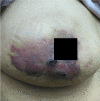Radiation-Associated Breast Angiosarcoma
- PMID: 37942397
- PMCID: PMC10628990
- DOI: 10.7759/cureus.46673
Radiation-Associated Breast Angiosarcoma
Abstract
Radiation-associated breast angiosarcomas are rare following breast-conserving surgery. These angiosarcomas are considered adverse events associated with radiation therapy and are characterized by a high risk of both local and distant recurrence, even after complete resection. Despite this, there is currently no established standard treatment for them. The patient was a 70-year-old woman who had breast-conserving surgery for right breast cancer 10 years before presentation. She was followed up for 10 years after receiving 50 Gy of residual breast irradiation and an aromatase inhibitor for 5 years. During follow-up, a painless purplish area with induration, measuring 10 cm by 5.4 cm, was noted on the right nipple. A skin biopsy confirmed hemangiosarcoma. Treatment included surgery with a 2.0 cm margin from the area, followed by skin excision and total mastectomy. A final diagnosis of radiation-associated breast angiosarcoma was made. Radiation-associated breast angiosarcoma is a rare disease with a poor prognosis that lacks standard treatment. An aggressive skin biopsy should be considered when skin findings such as purpura are seen after breast cancer radiotherapy, as in this case.
Keywords: breast-conserving surgery; purpura; radiation therapy; radiation-associated breast angiosarcoma; skin biopsy.
Copyright © 2023, Yoshino et al.
Conflict of interest statement
The authors have declared that no competing interests exist.
Figures





References
-
- Radiation-associated angiosarcoma of the breast: An international multicenter analysis. Mergancová J, Lierová A, Coufal O, et al. Surg Oncol. 2022;41:101726. - PubMed
-
- Radiation-induced angiosarcoma of the breast: A review. Bonito FJ, de Almeida Cerejeira D, Dahlstedt-Ferreira C, Oliveira Coelho H, Rosas R. https://doi.org/10.1111/tbj.13504. Breast J. 2020;26:458–463. - PubMed
-
- Radiation-associated angiosarcoma of the breast: analysis of diagnostic tools in a registry-based population. Salminen SH, Sampo MM, Böhling TO, Salo J, Tarkkanen M, Blomqvist CP, Hukkinen K. https://doi.org/10.1177/0284185120980142. Acta Radiol. 2022;63:22–27. - PubMed
-
- Radiation-associated angiosarcoma of the breast: analysis of diagnostic tools in a registry-based population. Salminen SH, Sampo MM, Böhling TO, Salo J, Tarkkanen M, Blomqvist CP, Hukkinen K. Acta Radiol. 2022;63:22–27. - PubMed
Publication types
LinkOut - more resources
Full Text Sources
